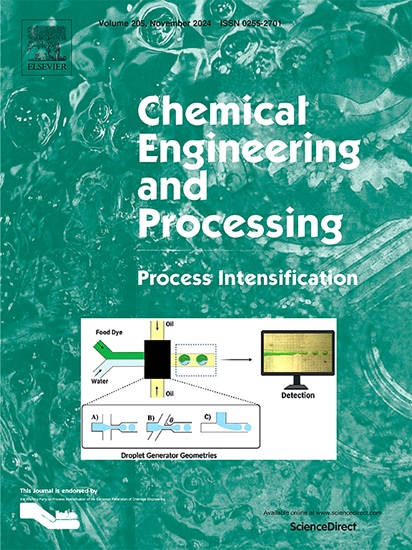采用全局优化技术建立超声乳化的经验模型:预测各种油水乳状液的液滴大小
IF 3.9
3区 工程技术
Q3 ENERGY & FUELS
Chemical Engineering and Processing - Process Intensification
Pub Date : 2025-05-27
DOI:10.1016/j.cep.2025.110381
引用次数: 0
摘要
基于Hinze和Taylor的基础理论,目前的理论关联主要将超声乳化(USE)过程中湍流状态下的液滴变形归因于湍流涡流产生的动水压力波动和液滴界面上的粘性应力。然而,这些现有的理论模型缺乏实验数据的全面验证和更广泛的适用性。因此,本文介绍了一个经验验证的USE模型,通过建立和拟合通过批量和流动USE生产的三种不同的O/ w乳液的乳化数据集,该模型适用于广泛的O/ w乳液体系。该数据集通过在拟合算法中实现人工智能工具进行建模,假设表征液滴形成过程的几个无量纲群之间存在幂律关系。本研究比较了三种全局优化技术(贝叶斯优化、粒子群优化和差分进化)的性能,后者表现出最优的性能。最后,获得了经验相关性,调整后的决定系数(Radj²)为0.81,相对均方根误差(RRMSE)为22%,在95%的置信水平上确保了±61 nm范围内的液滴尺寸预测精度,相对于平均液滴尺寸的预测精度为37%。此外,使用广泛的O/ w乳液的乳化数据验证了这种经验相关性,得出Radj²-系数为0.89,RRMSE为15%,强调了其更广泛的适用性。本文章由计算机程序翻译,如有差异,请以英文原文为准。

Employing global optimization techniques to establish an empirical model for ultrasound emulsification: Predicting the droplet size of various O/W-Emulsions
Current theoretical correlations, based on Hinze’s and Taylor's foundational theories, predominantly attribute droplet deformation in turbulent regimes during ultrasound emulsification (USE) to hydrodynamic pressure fluctuations and viscous stresses at the droplet interface, generated by turbulent eddies. However, these existing theoretical models lack comprehensive validation with experimental data and broader applicability. Thus, this paper introduces an empirically validated model for USE, applicable to a wide range of O/W-emulsion systems by establishing and fitting an emulsification dataset of three distinct O/W-emulsions produced through batch and flow USE. This dataset was modelled by implementing AI-tools in a fitting-algorithm, assuming power-law relationships between several dimensionless groups which characterize the droplet formation process. This study compares the performance of three Global Optimization Techniques - Bayesian Optimization, Particle Swarm Optimization, and Differential Evolution - with the latter exhibiting the most optimal performance. In the end, an empirical correlation was obtained achieving an adjusted coefficient of determination (Radj²) of 0.81 and a Relative Root Mean Squared Error (RRMSE) of 22 %, ensuring droplet size prediction accuracy within ±61 nm at a 95 % confidence level, corresponding to an prediction accuracy of 37 % relative to the average droplet size. Furthermore, this empirical correlation was validated using literature emulsification data of a wide range of O/W-emulsions, yielding an Radj²-coefficient of 0.89 and a RRMSE of 15 %, underscoring its broader applicability.
求助全文
通过发布文献求助,成功后即可免费获取论文全文。
去求助
来源期刊
CiteScore
7.80
自引率
9.30%
发文量
408
审稿时长
49 days
期刊介绍:
Chemical Engineering and Processing: Process Intensification is intended for practicing researchers in industry and academia, working in the field of Process Engineering and related to the subject of Process Intensification.Articles published in the Journal demonstrate how novel discoveries, developments and theories in the field of Process Engineering and in particular Process Intensification may be used for analysis and design of innovative equipment and processing methods with substantially improved sustainability, efficiency and environmental performance.

 求助内容:
求助内容: 应助结果提醒方式:
应助结果提醒方式:


